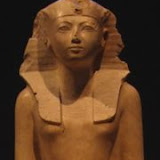 Hatshepsut meaning, Foremost of Noble Ladies, was the fifth pharaoh of the eighteenth dynasty of Ancient Egypt. She is generally regarded by Egyptologists as one of the most successful pharaohs, reigning longer than any other woman of an indigenous Egyptian dynasty.
Hatshepsut meaning, Foremost of Noble Ladies, was the fifth pharaoh of the eighteenth dynasty of Ancient Egypt. She is generally regarded by Egyptologists as one of the most successful pharaohs, reigning longer than any other woman of an indigenous Egyptian dynasty.
Although records of her reign are documented in diverse ancient sources, Hatshepsut once was described by early modern scholars as only having served as a co-regent from about 1479 to 1458 BC, during years seven to twenty-one of the reign previously identified as that of Thutmose III.
Now it is known widely that Hatshepsut assumed the position of pharaoh and her reign as king is usually given as twenty-two years since Manetho assigns her a reign of 21 years and 9 months. He was a historian who lived during the Ptolemaic era, during the third century B.C., and he had access to many records that have been lost. The date of her death is known to have occurred in 1458 BC, which implies that she became pharaoh circa 1479 BC.
Although it was uncommon for Egypt to be ruled by a woman, this situation was not unprecedented. Hatshepsut was the second known to have formally assumed power as "King of Upper and Lower Egypt" after Queen Sobekneferu of the Twelfth Dynasty.
As a queen regnant she is preceded by Merneith of the first dynasty; and Nimaethap of the third dynasty, who may have been the dowager of Khasekhemwy, but who certainly acted as regent for her son, Djoser, during the third dynasty, and—Nimaethap may have reigned as pharaoh in her own right. Ahhotep I, lauded as a warrior queen, may have been a regent between the reigns of two of her sons, Kamose and Ahmose I, at the end of the seventeenth dynasty and the beginning of Hatshepsut's own eighteenth dynasty. Amenhotep I, also preceding Hatshepsut in the eighteenth dynasty, probably came to power while a young child, and his mother, Ahmose-Nefertari, is thought to have been regent for him.
Other women whose possible reigns as pharaohs are under study include Nefertiti, Meritaten, Neferneferuaten, and Twosret. Another pharaoh, Smenkhkare, generally has been believed to have been male, but there is some evidence that this was a woman also.
Among the later, non-indigenous Egyptian dynasties, the most notable example of another woman who became pharaoh was Cleopatra VII, the last pharaoh of Ancient Egypt.
In comparison with other female pharaohs, her reign was long and prosperous. She was successful in warfare early in her reign, but is generally considered to be a pharaoh who inaugurated a long peaceful era.
She re-established trading relationships lost during a foreign occupation and brought great wealth to Egypt. That wealth enabled Hatshepsut to initiate building projects that raised the calibre of Ancient Egyptian architecture to a standard, comparable to classical architecture, that would not be rivaled by any other culture for a thousand years.
dentification of mummy
Hatshepsut's remains were long considered lost, but in June 2007 a mummy from Tomb KV60, was publicly identified as her remains by Zahi Hawass, the Secretary General of Egypt's Supreme Council of Antiquities. Evidence supporting this identification includes the results of a DNA comparison with the mummy of Ahmose Nefertari, Hatshepsut's great-grandmother and the matriarch of the 18th dynasty. Further conclusive evidence includes the possession of a molar with one root that fit the mummy's jaw as it had a gap that had one root as well. This molar was found inside a small wooden box inscribed with Hatshepsut's name and cartouche: Zahi Hawass's team's CAT scan revealed that this tooth exactly matches this mummy's jaw. Modern CT scans of that mummy believed to be Hatshepsut suggest she was about fifty years old when she died from a ruptured abscess after removal of a tooth. Although this was the cause, it is quite possible she would not have lived much longer; there are signs in her mummy of metastatic bone cancer, as well as possible liver cancer and diabetes. Egyptologists not involved in the project, however, have reserved acceptance of the findings until further testing is undertaken.
Family and early life
Hatshepsut was the elder daughter of Thutmose I and Queen Ahmose, the first king and queen of the Thutmoside clan of the eighteenth dynasty. Thutmose I and Ahmose are known to have had only one other child, a daughter, Akhbetneferu (Neferubity), who died as an infant. Thutmose I also married Mutnofret, possibly a daughter of Ahmose I, and produced several half-brothers to Hatshepsut: Wadjmose, Amenose, Thutmose II, and possibly Ramose, through that secondary union. Both Wadjmose and Amenose were prepared to succeed their father, but neither lived beyond adolescence.
In her childhood, Hatshepsut is believed to have been favored by the Temple of Karnak over her two half-brothers by her father. Hatshepsut apparently had a close relationship with both of her parents. Among the official records of her reign are assertions that her father, Thutmose I, named her as his direct heir and later, official depictions of Hatshepsut show her dressed in the full regalia of a pharaoh, including the traditional false beard of pharaohs to indicate that she ruled Egypt in her own right.
Upon the death of her father in 1493 BC, Hatshepsut married her half-brother, Thutmose II, and assumed the title of Great Royal Wife. Thutmose II ruled Egypt for either three or thirteen years, during which time it has traditionally been believed that Queen Hatshepsut exerted a strong influence over her husband.
Royal lineage was traced through the women in ancient Egypt. Marriage to a queen of the royal lineage was necessary for a male king, even if he came from outside of the lineage as happened occasionally. Secondary unions to other women in the royal family assured that there would be heirs from the lineage and women who could become the royal wives.[11] This is the reason for all of the intermarriages. The royal women also played a pivotal role in the religion of ancient Egypt. The queen officiated at the rites in the temples, as priestess, in a culture where religion was inexorably interwoven with the roles of the rulers. In Hatshepsut's time the royal daughter acted as an official adviser to the pharaoh as the high priestess.
Hatshepsut had one daughter with Thutmose II: Neferure. Some scholars hold that Hatshepsut and Thutmose II groomed Neferure as the heir apparent, commissioning official portraits of their daughter wearing the false beard of royalty and the sidelock of youth. Others speculate that she was being prepared to assume her mother's own roles as queen, but to have Neferure prepared to be a pharaoh, if necessary.
When Thutmose II died, he left behind only one son, a young Thutmose III to succeed him. The latter was born as the son of a lesser wife of Thutmose II rather than of the Great Royal Wife, Hatshepsut, as Neferure was. Due to the relative youth of Thutmose III, he was not eligible to assume the expected tasks of a pharaoh. Instead, Hatshepsut became the regent of Egypt at this time, assumed the responsibilities of state, and was recognized by the leadership in the temple. At this time, her daughter, Neferure, took over the roles Hatshepsut had played as queen in official and religious ceremonies. This political arrangement is detailed in the tomb autobiography of Ineni, a high official at court:
“ He (Thutmose II) went forth to heaven in triumph, having mingled with the gods; His son stood in his place as king of the Two Lands, having become ruler upon the throne of the one who begat him. His (Thutmose II's) sister the Divine Consort, Hatshepsut settled the affairs of the Two Lands by reason of her plans. Egypt was made to labour with bowed head for her, the excellent seed of the god (Thutmose I), which came forth from him.”
Thus, while Thutmose III was designated as a co-regent of Egypt, the royal court recognised Hatshepsut as the pharaoh on the throne until she died. It is believed that Neferure became the royal wife of Thutmose III and the mother of his eldest son, Amenemhat, who did not outlive his father.
Thutmose III ruled as pharaoh for more than thirty years after the death of Hatshepsut. This relationship between Neferure and Amenemhat is debated among authors, but since Neferure is depicted in her mother's funeral temple, there are some who believe that Neferure was still alive in the first few years of the rule by Thutmose III as pharaoh, that his eldest son, Amenemhat, was her child, and that he thereby was the heir to the throne of Thutmose III until he died.
Rule
Dates and length of reign
Hatshepsut was given reign about twenty-two years by ancient authors. Josephus writes that she reigned for twenty-one years and nine months while Africanus states her reign lasted twenty-two years, both of whom were quoting Manetho. At this point in the histories, records of the reign of Hatshepsut end, since the first major foreign campaign of Thutmose III was dated to his twenty-second year, which also would have been Hatshepsut's twenty-second year as pharaoh. Dating the beginning of her reign is more difficult, however. Her father's reign began in either 1506 or 1526 BC according to the low and high chronologies, respectively. However, the length of the reigns of Thutmose I and Thutmose II cannot be determined with absolute certainty. With short reigns, Hatshepsut would have ascended the throne fourteen years after the coronation of Thutmose I. Longer reigns would put her ascension twenty-five years after Thutmose I's coronation. Thus, Hatshepsut could have assumed power as early as 1512 BC or as late as 1479.
Modern chronologists, however, tend to agree that Hatshepsut reigned as pharaoh from 1479 to 1458 BC, but there is no definitive proof of the beginning date. These dates are derived from the closeness of length of her reign, related in the ancient records of Manetho, Africanus, and Josephus and counting backward from the date of her death, which is quite certain.
Major accomplishments
As Hatshepsut reestablished the trade networks that had been disrupted during the Hyksos occupation of Egypt during the Second Intermediate Period, thereby building a wealth of the eighteenth dynasty that has become so famous since the discovery of the burial of one of her descendants, Tutankhamun, began to be analyzed.
She oversaw the preparations and funding for a mission to the Land of Punt. The expedition set out in her name with five ships, each measuring 70 feet (21 m) long bearing several sails and accommodating 210 men that included sailors and 30 rowers. Many trade goods were bought in Punt, notably myrrh, which is said to have been Hatshepsut's favorite fragrance.
Most notably, however, the Egyptians returned from the voyage bearing 31 live frankincense trees, the roots of which were carefully kept in baskets for the duration of the voyage. This was the first recorded attempt to transplant foreign trees. It is reported that Hatshepsut had these trees planted in the courts of her Deir el Bahari mortuary temple complex. Egyptians also returned with living Puntites (people of Punt). This trading expedition to Punt was roughly during Hatshepsut's nineteenth year of reign.
She had the expedition commemorated in relief at Deir el-Bahri, which also is famous for its realistic depiction of the Queen of the Land of Punt ,Queen Iti, who appears to have had a genetic trait called steatopygia.
Hatshepsut also sent rading expeditions to Byblos and Sinai shortly after the Punt expedition. Very little is known about these expeditions.
Although many Egyptologists have claimed that her foreign policy was mainly peaceful, there is evidence that Hatshepsut led successful military campaigns in Nubia, the Levant, and Syria early in her career.
Building projects
Hatshepsut was one of the most prolific builders in ancient Egypt, commissioning hundreds of construction projects throughout both Upper and Lower Egypt, that were grander and more numerous than those of any of her Middle Kingdom predecessors.
She employed two great architects: Ineni, who also had worked for her husband and father and for the royal steward Senemut. During her reign, so much statuary was produced that almost every major museum in the world has Hatshepsut statuary among their collections; for instance, the Hatshepsut Room in New York City's Metropolitan Museum of Art is dedicated solely to these pieces.
Following the tradition of most pharaohs, Hatshepsut had monuments constructed at the Temple of Karnak. She also restored the original Precinct of Mut, the ancient great goddess of Egypt, at Karnak that had been ravaged by the foreign rulers during the Hyksos occupation. She had twin obelisks, at the time the tallest in the world, erected at the entrance to the temple. One still stands, as the tallest surviving ancient obelisk on Earth; the other has since broken in two and toppled. Another project, Karnak's Red Chapel, or Chapelle Rouge, was intended as a barque shrine and may have stood between her two obelisks originally. She later ordered the construction of two more obelisks to celebrate her sixteenth year as pharaoh; one of the obelisks broke during construction, and thus a third was constructed to replace it. The broken obelisk was left at its quarrying site in Aswan, where it still remains, known as The Unfinished Obelisk, serving as a demonstration of just how obelisks were quarried.
The Temple of Pakhet was built by Hatshepsut at Beni Hasan in the Minya Governorate south of Al Minya. Pakhet was a synthesis that occurred combining Bast and Sekhmet, who were similar lioness war goddesses, in an area that bordered the north and south division of their cults. The cavernous underground temple, cut into the rock cliffs on the eastern side of the Nile, was admired and called the Speos Artemidos by the Greeks during their occupation of Egypt, known as the Ptolemaic Dynasty. They saw the goddess as a parallel to their hunter goddess Artemis. The temple is thought to have been built alongside much more ancient ones that have not survived. This temple has an architrave bearing a long dedicatory text bearing Hatshepsut's famous denunciation of the Hyksos that has been translated by James P. Allen. They had occupied Egypt and cast it into a cultural decline that persisted until a revival brought about by her policies and innovations. This temple was altered later and some of its inside decorations were usurped by Seti I, in the nineteenth dynasty, attempting to have his name replace that of Hatshepsut.
The masterpiece of Hatshepsut's building projects was her mortuary temple complex at Deir el-Bahri. It was designed and implemented by Senemut at a site on the West Bank of the Nile River near the entrance to what is now called the Valley of the Kings because of all the pharaohs who later chose to associate their complexes with the grandeur of hers. Her buildings were the first grand ones planned for that location. The focal point was the Djeser-Djeseru or "the Sublime of Sublimes", a colonnaded structure of perfect harmony nearly one thousand years before the Parthenon was built. Djeser-Djeseru sits atop a series of terraces that once were graced with lush gardens. Djeser-Djeseru is built into a cliff face that rises sharply above it. Djeser-Djeseru and the other buildings of Hatshepsut's Deir el-Bahri complex are considered to be among the great buildings of the ancient world. Also another one of her great accomplishments is the Hatshepsut needle (also known as the granite obelisks).
Official lauding vs. propaganda
While all ancient leaders used propaganda to laud their achievements, Hatshepsut has been called the most accomplished pharaoh at promoting her accomplishments. This may have resulted from the extensive building executed during her time as pharaoh in comparison to many others because it afforded her with opportunities to laud herself, but it also reflects the wealth that her policies and administration brought to Egypt, enabling her to finance such projects. Aggrandizement of their achievements was traditional when pharaohs built temples and their tombs. Hyperbole is common, virtually, to all royal inscriptions of Egyptian history. The term propaganda is rarely applied to similar activities by male pharaohs, and raises the question of why it is used here. Much of her decorative reliefs had religious overtones and was supported fully by the officials at the Temple of Karnak. Since the passage of leadership was determined in advance by these same religious leaders, and enacted at the moment of the death of a pharaoh, the transition to the next occurred without question and immediately. Hence, there was no need to influence "public opinion" or for the subtle manipulation associated with the concept of "propaganda" that is implied in some scholarship about Hatshepsut. Selected by the religious leaders and assisted by an accomplished administration, she ruled over a kingdom that, markedly, prospered under her rule
Women had a high status in ancient Egypt and enjoyed the legal right to own, inherit, or will property. As noted previously, lineage was traced through maternal relationships. A woman becoming pharaoh was rare, however, only Khentkaues, Sobeknefru, and possibly Nitocris preceded her in known records as ruling solely in their own name. The latter's existence is disputed and is likely a mis-translation of a male king. Twosret, a female king and the last pharaoh of the nineteenth dynasty, may have been the only woman to succeed her among the indigenous rulers, although research continues about others. At that point in Egyptian history, there was no word for a queen regnant, pharaoh had become the name for the ruler. Hatshepsut is not unique, however, in taking the title of king. Sobekneferu, ruling six dynasties prior to Hatshepsut, also did so when she ruled Egypt. Hatshepsut had been well trained in her duties as the daughter of the pharaoh. During her father's reign she held the powerful office of God's Wife of Amun as well as the Divine Adoratrice of Amun. She had taken a strong role as queen to her husband and was well experienced in the administration of her kingdom by the time she became pharaoh. There is no indication of challenges to her leadership and, until her death, her co-regent remained in a secondary role, quite amicably heading her powerful army—which would have given him the power necessary to overthrow a usurper of his rightful place, if that had been the case.
Hatshepsut assumed all of the regalia and symbols of the pharaonic office in official representations: the Khat head cloth, topped with the uraeus, the traditional false beard, and shendyt kilt. Many existing statues alternatively show her in typically feminine attire as well as those that depict her in the royal ceremonial attire. Statues portraying Sobekneferu also combine elements of traditional male and female iconography and, by tradition, may have served as inspiration for these works commissioned by Hatshepsut. After this period of transition ended, however, all formal depictions of Hatshepsut as pharaoh showed her in the royal attire, with all of the pharaonic regalia, and with her breasts obscured behind her crossed arms holding the regal staffs of the two kingdoms she ruled, as the symbols of the pharaoh were much more important to be displayed traditionally.
The reasons for her breasts not being emphasized in the most formal statues were debated among early Egyptologists who never drew a parallel to the fact that many women and goddesses portrayed in ancient Egyptian art lack delineation of breasts and that the gender of pharaohs was never stressed in ancient Egyptian Art. Interpretations by these early scholars were that her motivation for wearing men's clothing was a personal choice.
Modern scholars, however, have opted for an alternative theory: that by assuming the typical symbols of pharaonic power, Hatshepsut was asserting her claim to be the sovereign and not a "King's Great Wife" or Queen consort. The gender of pharaohs was never stressed in official depictions, even the men were depicted with the highly stylized false beard associated with their position in the society. Moreover, the Osirian statues of Hatshepsut—as with other pharaohs—depict the dead pharaoh as Osiris, with the body and regalia of that deity. All of the statues of Hatshepsut at her tomb follow that tradition. The promise of resurrection after death was a tenet of the cult of Osiris. Since there are so many of these, statues of Hatshepsut depicted in this fashion have been widely published and put on display in museums and, viewers without an understanding of the religious significance have been misled.
Most of the official statues commissioned of Hatshepsut show her less symbolically and more naturally, as a woman in typical dresses of the nobility of her day. Notably, even after assuming the formal regalia, Hatshepsut still described herself as a beautiful woman, often as the most beautiful of women, and although she assumed almost all of her father's titles, she declined to take the title "The Strong Bull" (the full title being, The Strong Bull of his Mother), which tied the pharaoh to the goddesses Isis, the throne, and Hathor, (the cow who gave birth to and protected the pharaohs), by being her son sitting on her throne -- an unnecessary title for her, since Hatshepsut became allied with the goddesses, herself, which no male pharaoh could. Rather than the strong bull, Hatshepsut associated herself with the image of Sekhmet, the major war deity in the Egyptian pantheon, having served as a very successful warrior during the early portion of her reign as pharaoh.
Religious concepts were tied into all of these symbols and titles. By the time of Hatshepsut's reign, the merger of some aspects of these two goddesses provided that they would both have given birth to, and were the protectors of, the pharaohs. They became interchangeable at times. Hatshepsut also traced her lineage to Mut, a primal mother goddess of the Egyptian pantheon, which gave her another ancestor who was a deity as well as her father, who would have become deified upon death.
While Hatshepsut was depicted in official art wearing regalia of a pharaoh, such as the false beard that male pharaohs also wore, it is most unlikely that she ever wore such ceremonial decorations, just as it is unlikely that the male pharaohs did. Statues such as those at the Metropolitan Museum of Art, depicting her seated wearing a tight-fitting dress and the nemes crown, are thought to be a more accurate representation of how she would have presented herself at court.
As a notable exception, only one male pharaoh abandoned the rigid symbolic depiction that had become the style of the most official artwork representing the ruler, Pharaoh Amenhotep IV (later Akhenaten) of the same eighteenth dynasty, whose wife, Nefertiti, also may have ruled in her own right following the death of her husband. Nefertiti is thought to have been a woman from the same lineage as Hatshepsut.
One of the most famous examples of the legends about Hatshepsut is a myth about her birth. In this myth, Amun goes to Ahmose in the form of Thutmose I and awakens her with pleasant odors. At this point Amun places the ankh, a symbol of life, to Ahmose's nose, and Hatshepsut is conceived by Ahmose. Khnum, the god who forms the bodies of human children, is then instructed to create a body and ka, or corporal presence/life force, for Hatshepsut. Heket, the goddess of life and fertility, and Khnum then lead Ahmose along to a lioness bed where she gives birth to Hatshepsut.
The Oracle of Amun proclaimed that it was the will of Amun that Hatshepsut be pharaoh, further strengthening her position. She reiterated Amun's support by having these proclamations by the god Amun carved on her monuments:
“ Welcome my sweet daughter, my favorite, the King of Upper and Lower Egypt, Maatkare, Hatshepsut. Thou art the Pharaoh, taking possession of the Two Lands. ”
Hatshepsut claimed that she was her father's intended heir and that he made her the heir apparent of Egypt. Almost all scholars today view this as historical revisionism on Hatshepsut's part since it was Thutmose II--a son of Thutmose I by Mutnofret--who was her father's heir. Moreover, Thutmose I could not have foreseen that his daughter Hatshepsut would outlive his son within his own lifetime. Thutmose II soon married Hatshepsut and the latter became both his senior royal wife and the most powerful woman at court. Evelyn Wells, however, accepts Hatshepsut's claim that she was her father's intended successor. Once she became pharaoh herself, Hatshepsut supported her assertion that she was her father's designated successor with inscriptions on the walls of her mortuary temple:
“ Then his majesty said to them: "This daughter of mine, Khnumetamun Hatshepsut—may she live!—I have appointed as my successor upon my throne... she shall direct the people in every sphere of the palace; it is she indeed who shall lead you. Obey her words, unite yourselves at her command." The royal nobles, the dignitaries, and the leaders of the people heard this proclamation of the promotion of his daughter, the King of Upper and Lower Egypt, Maatkare—may she live eternally. ”
American humorist Will Cuppy wrote an essay on Hatshepsut which was published after his death in the book The Decline and Fall of Practically Everybody. Regarding one of her wall inscriptions, he wrote,
“For a general notion of Hatshepsut's appearance at a certain stage of her career, we are indebted to one of those wall inscriptions. It states that "to look upon her was more beautiful than anything; her splendor and her form were divine." Some have thought it odd that the female Pharaoh should have been so bold, fiftyish as she was. Not at all. She was merely saying how things were about thirty-five years back, before she had married Thutmose II and slugged it out with Thutmose III. "She was a maiden, beautiful and blooming", the hieroglyphics run, and we have no reason to doubt it. Surely there is no harm in telling the world how one looked in 1514 B.C.
Death
Hatshepsut died as she was approaching, what we would consider middle age given typical contemporary lifespans, in her twenty-second regnal year. The precise date of Hatshepsut's death--and the time when Thutmose III became pharaoh of Egypt--is considered to be Year 22, II Peret day 10 of their joint rule as recorded on a single stela erected at Armant or January 16, 1458 BC. This information validates the basic reliability of Manetho's kinglist records since Thutmose III and Hatshepsut's known accession date was I Shemu day 4. (ie: Hatshepsut died 9 months into her 22nd year as Manetho writes in his Epitome for a reign of 21 years and 9 months) No mention of the cause of her death has survived. If the recent identification of her mummy in KV60 is correct,however, CT scans would indicate that she died of blood infection while she was in her 50s. it also would suggest that she had arthritis, bad teeth, and probably had diabetes.
For a long time, her mummy was believed to be missing from the Deir el-Bahri Cache. An unidentified female mummy—found with Hatshepsut's wet nurse, Sitire-Re, one of whose arms was posed in the traditional burial style of pharaohs—has led to the theory that the unidentified mummy in KV60 might be Hatshepsut. Don Ryan working with Pacific Lutheran University and the Evergreen State College reopened KV60 in 1989, which had been resealed after it was discovered at the turn of the century. The tomb had been damaged, but the mummies remained in site.
In March 2006, Zahi Hawass claimed to have located the mummy of Hatshepsut, which was mislaid on the third floor of the Cairo Museum. In June 2007, it was announced that Egyptologists believed they had identified Hatshepsut's mummy in the Valley of the Kings; this discovery is considered to be the "most important find in the Valley of the Kings since the discovery of King Tutankhamun". Decisive evidence was a molar found in a wooden box that was inscribed with Hatshepsut's name, found in 1881 among a cache of royal mummies hidden away for safekeeping in a near-by temple. The tooth has been conclusively proven to have been removed from the mummy's mouth, fitting exactly an empty socket in the mummy's jawbone.
Burial complex
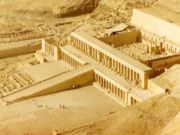 Hatshepsut had begun construction of a tomb when she was the Great Royal Wife of Thutmose II, but the scale of this was not suitable when she became pharaoh, so a second tomb was built. This was KV20, which possibly was the first tomb to be constructed in the Valley of the Kings. The original intention seems to have been to hew a long tunnel that would lead underneath her mortuary temple, but the quality of the limestone bedrock was poor and her architect must have realized that this goal would not be possible. As a result, a large burial chamber was created instead. At some point, it was decided to dis-inter her father, Thutmose I, from his original tomb in KV38 and place his mummy in a new chamber below hers. Her original red-quartzite sarcophagus was altered to accommodate her father instead, and a new one was made for her. It is likely that when she died (no later than the twenty-second year of her reign), she was interred in this tomb along with her father.
Hatshepsut had begun construction of a tomb when she was the Great Royal Wife of Thutmose II, but the scale of this was not suitable when she became pharaoh, so a second tomb was built. This was KV20, which possibly was the first tomb to be constructed in the Valley of the Kings. The original intention seems to have been to hew a long tunnel that would lead underneath her mortuary temple, but the quality of the limestone bedrock was poor and her architect must have realized that this goal would not be possible. As a result, a large burial chamber was created instead. At some point, it was decided to dis-inter her father, Thutmose I, from his original tomb in KV38 and place his mummy in a new chamber below hers. Her original red-quartzite sarcophagus was altered to accommodate her father instead, and a new one was made for her. It is likely that when she died (no later than the twenty-second year of her reign), she was interred in this tomb along with her father.
The tomb was opened in antiquity, the first time during the end of the reign of Hatshepsut's successor, Thutmose III, who re-interred his grandfather, Thutmose I, in his original tomb, and may have moved Hatshepsut's mummy into the tomb of her wet nurse, Sitre-Re, in KV60. It is possible that Amenhotep II, successor to Thutmose III was the one motivating these actions in an attempt to assure his own succession. Although her tomb largely had been cleared (save for both sarcophagi still present when the tomb was fully cleared by Howard Carter in 1903) some grave furnishings have been identified as belonging to Hatshepsut, including a "throne" (bedstead is a better description), a senet game board with carved lioness-headed, red-jasper game pieces bearing her pharaonic title, a signet ring, and a partial ushabti figurine bearing her name. In the Royal Mummy Cache at DB320 an ivory canopic coffer was found that was inscribed with the name of Hatshepsut and contained a mummified liver. However, there was a royal lady of the Twenty-first dynasty of the same name, and this could belong to her instead.
Labels: Historical woman
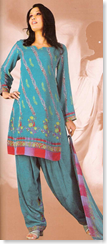



 Myth 2: Trimming Leads to Faster Hair Growth
Myth 2: Trimming Leads to Faster Hair Growth
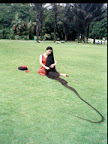 The world's longest documented hair belongs to Xie Qiuping (China) at 5.627 m (18 ft 5.54 in) when measured on May 8, 2004. She has been growing her hair since 1973 from the age of 13.
The world's longest documented hair belongs to Xie Qiuping (China) at 5.627 m (18 ft 5.54 in) when measured on May 8, 2004. She has been growing her hair since 1973 from the age of 13.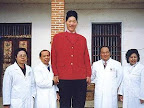 De-Fen Yao from China who stands at 7'7 85/100" (233,3cm) confirmed!
De-Fen Yao from China who stands at 7'7 85/100" (233,3cm) confirmed!  Clarissa Harlowe Barton (December 25, 1821 – April 12, 1912) was a pioneer American teacher, nurse, and humanitarian.
Clarissa Harlowe Barton (December 25, 1821 – April 12, 1912) was a pioneer American teacher, nurse, and humanitarian.  Hatshepsut meaning, Foremost of Noble Ladies, was the fifth pharaoh of the eighteenth dynasty of Ancient Egypt. She is generally regarded by Egyptologists as one of the most successful pharaohs, reigning longer than any other woman of an indigenous Egyptian dynasty.
Hatshepsut meaning, Foremost of Noble Ladies, was the fifth pharaoh of the eighteenth dynasty of Ancient Egypt. She is generally regarded by Egyptologists as one of the most successful pharaohs, reigning longer than any other woman of an indigenous Egyptian dynasty.  Hatshepsut had begun construction of a tomb when she was the Great Royal Wife of Thutmose II, but the scale of this was not suitable when she became pharaoh, so a second tomb was built. This was KV20, which possibly was the first tomb to be constructed in the Valley of the Kings. The original intention seems to have been to hew a long tunnel that would lead underneath her mortuary temple, but the quality of the limestone bedrock was poor and her architect must have realized that this goal would not be possible. As a result, a large burial chamber was created instead. At some point, it was decided to dis-inter her father, Thutmose I, from his original tomb in KV38 and place his mummy in a new chamber below hers. Her original red-quartzite sarcophagus was altered to accommodate her father instead, and a new one was made for her. It is likely that when she died (no later than the twenty-second year of her reign), she was interred in this tomb along with her father.
Hatshepsut had begun construction of a tomb when she was the Great Royal Wife of Thutmose II, but the scale of this was not suitable when she became pharaoh, so a second tomb was built. This was KV20, which possibly was the first tomb to be constructed in the Valley of the Kings. The original intention seems to have been to hew a long tunnel that would lead underneath her mortuary temple, but the quality of the limestone bedrock was poor and her architect must have realized that this goal would not be possible. As a result, a large burial chamber was created instead. At some point, it was decided to dis-inter her father, Thutmose I, from his original tomb in KV38 and place his mummy in a new chamber below hers. Her original red-quartzite sarcophagus was altered to accommodate her father instead, and a new one was made for her. It is likely that when she died (no later than the twenty-second year of her reign), she was interred in this tomb along with her father. 